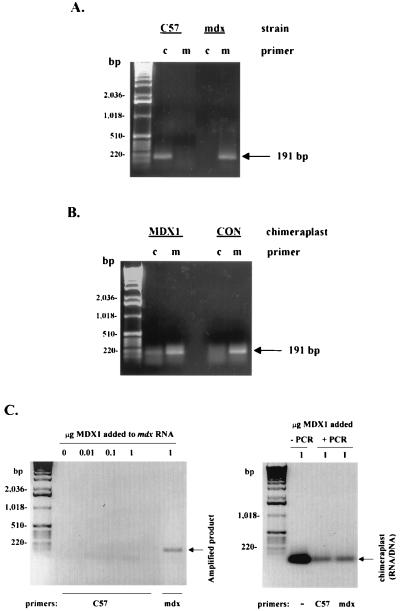Figure 6.
Evidence of gene conversion by MDX1 chimeraplasts. (A) Total RNA was isolated from C57 or mdx muscle and analyzed for dystrophin transcripts using RT-PCR and the mdx-ARMS assay. Two different 3′ primers, designated “C” and “M,” were designed to amplify only the wild-type (C57) sequence or only the mdx sequence, respectively. The exquisite specificity is shown by the presence of a 191-bp amplification product in C57 muscle only when the “C” primer was used and in mdx muscle only when the “M” primer was used. (B) Total RNA was isolated from mdx muscle injected with either MDX1 or control chimeraplasts. We tested for the presence of transcripts containing the wild-type dystrophin sequence (evidence of nucleotide exchange) using the same procedure as in A. A PCR amplification product using the “C” primer was seen in mdx muscles injected with the MDX1 chimeraplast, indicating the presence of wild-type transcripts, but not in mdx muscles injected with control chimeraplast. (C) Controls for potential PCR artifacts. (Left) RNA was prepared from uninjected mdx muscle, and different amounts of MDX1 were added to each sample, as indicated. Each sample was then subjected to RT-PCR using the “C57” primers to test whether the presence of MDX1 itself could result in artifactual amplification of a PCR product. No amplification product was detected. When the “mdx” primers were used, an amplification product of 191-bp was detected, as in B, reflecting appropriate amplification from the mdx transcripts. (Right) One microgram of MDX1 was either loaded directly onto the gel (left lane, “−PCR”) or was added to PCR solutions with either the “C57” or “mdx” primers (“+PCR” lanes). After the PCR, approximately 20% of each reaction volume (thus approximately 0.2 μg of added chimeraplast) was loaded onto the gel. The RNA/DNA oligonucleotide runs at the position indicated, and no PCR amplification product was detected with either set of primers.

